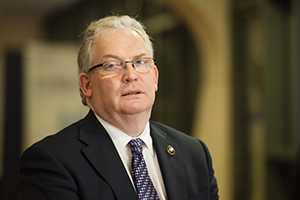Health service reform

Tony O’Brien, the HSE’s Director General discusses with Owen McQuade the challenges of reforming Ireland’s Health Services.
The public health sector should continuously be reforming and improving; it should never be satisfied with the status quo and should always be seeking to make positive changes that will benefit both the patient and society as a whole, according to the Health Service Executive’s (HSE) Director General Tony O’Brien.
Change
O’Brien believes that since 2008, Ireland’s health service has been undergoing significant change and such changes reflect how Irish society itself is evolving and changing. This is none more evident than life expectancy for both males and females in Ireland which is now above the EU-28 average. Since 2008, the number of people living in Ireland over the age of 65 has grown by 21 per cent which, as O’Brien notes, is “very positive but has a big impact on the way we provide health care.”
There is little doubt that the recent economic recession has somewhat forced the Health Service to further reform and change how it goes about its work. The staff moratorium introduced during the recession resulted in a significant reduction of headcount between 2009 and 2014. Notwithstanding, reduced staff and available resources the HSE’s monthly Performance Reports indicate that the health services are delivering greater output now than ever before. For example, in 2012, 2.35 million outpatient appointments were held. In 2014, despite fewer staff numbers, 3.2 million appointments were carried out. Despite on-going negative media coverage, it is a similar story in our hospitals’ emergency departments where attendance has increased 7 per cent from 1.1 million to over 1.18 million from 2012 to 2014. O’Brien says, “clearly we are very much aware that the experience of those requiring a bed having gone through an emergency department is not what we would like it to be.” He is however, upbeat about the fact that with just over 103,000 staff (and having experienced a reduction of over 9,700 staff since 2007), the Health Services are operating with a larger output than it ever has before.
Pointing to other significant changes over the past eight years, O’Brien highlighted the centralisation to eight cancer centres and the subsequent increase in the number of breast cancer referrals. Today, he notes, 94 per cent of all breast cancer referrals are now seen within two weeks of referral, a huge change from the end of 2007. According to O’Brien, there are many other instances of significant improvement within the Health Services that he believes demonstrate that with the right circumstances, health system reform has the capacity for direct change which has a direct bearing on the care and help people get.
Health service reform is not simply about increasing the number of patients and appointments, it is also about providing new services that have not existed previously. Examples of these include the establishment of a bilateral cochlear implant service and a national organ donation transplantation office. O’Brien also emphasises the completion, since 2012, of 33 new primary care centres throughout the country which support a wide variety of integrated services such as physiotherapy and occupational therapy. Community Intervention Teams have also increased in number from four to 10. Significantly, he notes, these services allow patients to receive more services within or as close as possible to their homes.
The number of people who have been granted a medical card or a GP visit card has also increased significantly in the past eight years. A medical card provides access not just to GP services but medications and a wide range of outpatient services. Medical cards can be, O’Brien believes, transformative in terms of health care to those whose financial means prevents them from accessing treatment or care.
There has also been a significant reduction in the waiting period for admissions to a nursing home bed, a 26 per cent increase in the number of clients who receive home care packages and a 5 per cent increase in clients who receive home help. The Health Service’s newly introduced delayed discharge initiative has also been rolled out specifically to address some of the issues impacting upon emergency departments.
Broad reform
Cleary, the reform of the HSE has been very broad, with much changing in the past eight years. While such a broad reform over such a long period of time has proved challenging for all staff members, O’Brien believes it is their dedication and commitment to improving services that has made all of these changes possible.
“The Health Service is very diverse,” says O’Brien. We are operating out of over 2,500 locations, with five main service divisions, seven hospital groups and nine community health organisations. This structure involves lots of different teams providing direct services from fixing breaks and cuts, to helping the elderly in their homes, to registering births and marriages. It is impossible for massive public sector reform, such as reforming the way over 100,000 health services workers operate at the frontline level, to succeed unless there is a clear vision from me that the staff understand and makes sense to people. We need both a high-level vision and a supporting set of clear steps that is capable of being understood at all levels of the organisation and at each different health service facility. In the Health Service that is what I think we are trying to achieve, and are seeing. We have a hugely committed staff looking to see what they can do to make the best of the resources that they have and to improve in small ways the service they are providing. When you bring together the important changes at ground-level with the large-scale improvements in structures and processes, you then get to see and experience real reform.”
 What is often not understood is that improving the health and wellbeing of the nation involves much more than the HSE and the Department of Health. One of the biggest government wide initiatives launched in the past eight years has been the Healthy Ireland Framework for improved health and wellbeing. The very welcome strategy is cross sectoral and recognises that when a patient enters the health system, it is, in some respects, already too late. One of the goals of Healthy Ireland is to increase the proportion of people who are healthy at all stages of life. This requires that, at individual and society level, we change behaviours and ensure a focus on people’s long-term health and wellbeing.
What is often not understood is that improving the health and wellbeing of the nation involves much more than the HSE and the Department of Health. One of the biggest government wide initiatives launched in the past eight years has been the Healthy Ireland Framework for improved health and wellbeing. The very welcome strategy is cross sectoral and recognises that when a patient enters the health system, it is, in some respects, already too late. One of the goals of Healthy Ireland is to increase the proportion of people who are healthy at all stages of life. This requires that, at individual and society level, we change behaviours and ensure a focus on people’s long-term health and wellbeing.
The strategy is obviously paying dividends as O’Brien highlights some of its successes, particularly in relation to behavioural change. For example, the QUIT campaign has helped to reduce the incidence of smoking from 24.5 per cent to 19.5 per cent in the past four years and up to 600,000 quit attempts recorded. This, he claims, is an example of effective cooperation between the health and the education sectors.
Another area that is receiving significant attention according to O’Brien, is the avoidance of harm in health care settings. O’Brien believes this means, amongst many other factors, a strong focus on preventing and controlling infections in hospitals and improving anti-microbial resistance programmes. O’Brien says that to date, there have been impressive successes including a 24 per cent reduction in C-Difficile per 10,000 bed days used and a decrease in the use of broad-spectrum antibiotics. In listing some of these improvements in the health services, O’Brien credited it all to the “individual interactions and hard-work of individual members of our staff.”
 Primary Care and Social Care services are often termed “the Cinderella’s” in many health services. As part of the recent reform, O’Brien describes how the establishment of Primary Care and Social Care Divisions, in their own right, has helped to rebalance the focus towards both of these important areas of the health service and that they have expanded accordingly. Undoubtedly the expansion of both of these Divisions has proved a huge undertaking. O’Brien claims that the Health Service needed this often unseen investment to meet future demands. O’Brien is quick to point out that people are always keen to see new hospitals. “Hospitals are big, shiny major pieces of economic infrastructure in their local areas,” he says. “Yet the vast majority of people get their health care somewhere else, in general practice, primary care, long-term care or other community settings”.
Primary Care and Social Care services are often termed “the Cinderella’s” in many health services. As part of the recent reform, O’Brien describes how the establishment of Primary Care and Social Care Divisions, in their own right, has helped to rebalance the focus towards both of these important areas of the health service and that they have expanded accordingly. Undoubtedly the expansion of both of these Divisions has proved a huge undertaking. O’Brien claims that the Health Service needed this often unseen investment to meet future demands. O’Brien is quick to point out that people are always keen to see new hospitals. “Hospitals are big, shiny major pieces of economic infrastructure in their local areas,” he says. “Yet the vast majority of people get their health care somewhere else, in general practice, primary care, long-term care or other community settings”.
“Those are the things that get people out of hospital and prevent them from going in. Over time, the challenge is, particularly when you are resource constrained, to focus your investment as best you can on those activities, whilst also recognising that hospitals are critically important and need to be sustained as well. I think it is remarkable the extent to which primary and social care has prospered in difficult times and the challenge is to continue to do that.”
Future
A health service that is never satisfied with its performance will always strive to improve and for O’Brien, the next natural step is to continue to integrate the Healthy Ireland Framework into the public health agenda and focus on the expansion of primary and social care as a way of early intervention and hospital avoidance. He also spoke of his desire, following a long period of underinvestment, to reform the Health Service’s ICT and financial systems to support e-health and self-care.
On top of these plans, the HSE are currently rolling out integrated models of care focused on the frail elderly, urgent and emergency care. Clinical Leads for the five service divisions have been appointed at national level to ensure proper alignment between innovation and the organisation of services. Significant work is also underway on HSE’s HR, ICT, e-health and finance processes to ensure the delivery of service is relevant to the future of the services. Furthermore, platforms are being developed at both national and more front-line levels in order to have more appropriate communication and conversations with our patients, clients and staff. Consequently, there is considerable focus on increased patient engagement and developing digital and social media communications.
Plans are also in place for the creation of strong academic health centres at hospital group level. All non-acute services are being reorganised into nine area based community health organisations that the public can relate to. The ambulance service has also been transformed and the National Emergency Operations Centre now operates over two sites on a single platform. These changes support the Health Service to use the resources they have most effectively.
However, despite these substantial plans and initiatives now in place, O’Brien acknowledged that despite the investment that is required now, the benefits will only be fully realised further down the line. O’Brien admits that as the HSE operates within a one year budgetary environment, investment is not rewarded within that timeframe. “If you take a three year view and had a three year budget, it would make so much more sense to start moving money. However, as we operate within a one year budgetary environment that payback is much less obvious,” he said. “You have to spread the resource relatively thin to make the most important changes. The system works really well when all the bits join up. This is why integrated care is now the trend across Europe. The focus on the integration of care and services like e-health are critical to the future functioning of the system. Unless we embrace integration, our health care system will not just be sub-optimal from a patient care perspective but is highly unlikely to be financially stable or sustainable.”
Staff morale
Reflecting on the hit that staff morale has taken over the past eight years, O’Brien acknowledges that “the years of austerity have been tough for our staff and have to some extent alienated many of them from the organisation they work for.” An employee engagement survey, carried out in late 2014, presents the HSE with a roadmap to re-engage their staff and O’Brien is adamant that roadmap will be followed. “Right now we have a fully committed workforce that is unclear about what is expected from them,” he said. “They can’t connect what we say, with what we do and they don’t feel as valued as they actually are.”
“We are going to repeat the survey roughly every 18 months and we have made the results visible and transparent. It also showed that the last six to seven years have been very hard on staff morale. We know that a significant number of staff have left and some of those remaining have been appointed into more senior positions earlier than they may have intended and they haven’t always been supported to develop their own skills and confidence to fulfil those roles. It has led to a fundamental re-evaluation of our People Strategy which we are beginning to roll out. We are also re-invigorating our leadership programmes.
The survey findings also tell us that we need to communicate better about the strengths of our services and also to listen better to staff. None of this is, or should be, a surprise. It is however, good to get it quantified and highlight what our staff want to say to us and most importantly. The overall participation in the survey was lower than we would have liked but it was representative.”
Alongside the challenge of combating lowering staff morale, the health service must also meet the challenge of rising public expectations. This rising expectation is something O’Brien is all too aware the health service will have to face moving forward. “Whether we have come through the economic downturn or not, the public and the political system will have to understand that to integrate new technologies and to reform such a massive organisation properly comes at a cost. We need to continue to ensure we make maximum cost savings and reductions smartly in collaboration with our workforce to ensure we are not unnecessarily wasting any badly needed funds to meet the needs of our population,” said O’Brien. “Our new corporate plan’s vision is simple, everything we do must be designed to create and support a healthier Ireland with a high quality health service valued by all. We are learning the lessons of the mistakes of the past and building a platform capable of delivering the service we need in the future. Of all the priorities we have, patient safety comes first.”

